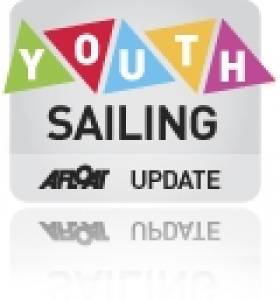Displaying items by tag: youth sailors
#optimist – Anyone looking at the 254 young sailors – mostly thirteen to fifteen year olds – milling around at the closing ceremony of the recent Optimist European Championships in Dun Laoghaire on Dublin Bay last weekend might wonder what future participation in sailing holds for them writes David O'Brien.
No crystal ball is available but it is possible to research with the help of Google what has happened to their opposite numbers of ten years ago, the participants in the championship of 2004 held in Sandhamn in Sweden. What follows is the result of such research seen by Afloat.ie into a random 20% sample of those sailors.
From the start it must be said that these 2004 sailors were already an 'elite'. They had qualified at national level on the basis of trials almost always involving over a hundred contemporaries and in larger countries far more. They are the equivalent in sailing of the young athletes from all the other Olympic sports who will be participating in the Youth Olympic Games in China this August. Indeed around 60% of the sailors who will be competing in dinghies in those Youth Olympics will be graduates of IODA championships (the Optimist worlds and the five continental championships of which the European Championship is one).
Mention was made at the Dun Laoghaire closing ceremony of the link to the real Olympics and that 60% of participants in 2012 had sailed in IODA events. However with just 318 dinghy places in Rio 2016 the chances to qualify of any one of the 800 sailors a year participating in IODA championships are limited. To date only six of the 268 in Sandhamn have become Olympians. Unlike some other sports such as tennis sailing is not in general a professional sport and very few of the sailors of 2004 have even received expenses to continue to compete.
The methodology of the study was to Google the names of every fifth sailor and note the latest year in which he or she could be found on the results sheet of any sailing competition. The sample size is thus 34 boys and 20 girls. Admittedly, this study is not perfect since the names of the sailors crewing on bigger boats are rarely shown in the results, and secondly transliteration of names especially in languages such as Greek can vary.
As a result the following figures are probably an under-estimate especially as the sailors get older and are more likely to be crewing on bigger boats.
The percentages found to be competing are as follows:
| Year | 2006 | 2008 | 2010 | 2012 |
| Average age | 16 | 18 | 20 | 22 |
| Boys | 85% | 79% | 74% | 62% |
| Girls | 90% | 80% | 55% | 35% |
This study throws no light on why the percentage of females declines so sharply at 18+. It is notable that four of the seven girls in the sample known to be still sailing at age 22 were sailing Olympic Class boats whereas only six of the 21 boys were doing so, but this sample may be statistically too small for such detailed analysis to be valid.
The future sailing of the 2004 Irish team is not statistically significant (one country in one year) but similar Google research showed that more of the 2004 Irish girls continued to sail than the global figures above, the Irish boys rather fewer.
While it is relatively easy to study, as above, the future sailing of a small elite, similar research for larger numbers presents problems. In France, the meticulous documentation kept by the French Federation suggests that around 50% of those who race at any level in the 10-14 age brackets continue to do so, mostly in keelboats, past eighteen. Worldwide any data about those who sail but do not race appear to be totally unreliable.
What does the future hold for our children? No one knows for sure but, thanks to Google, at least we can start to sketch a picture of sailing's class of 2004.























